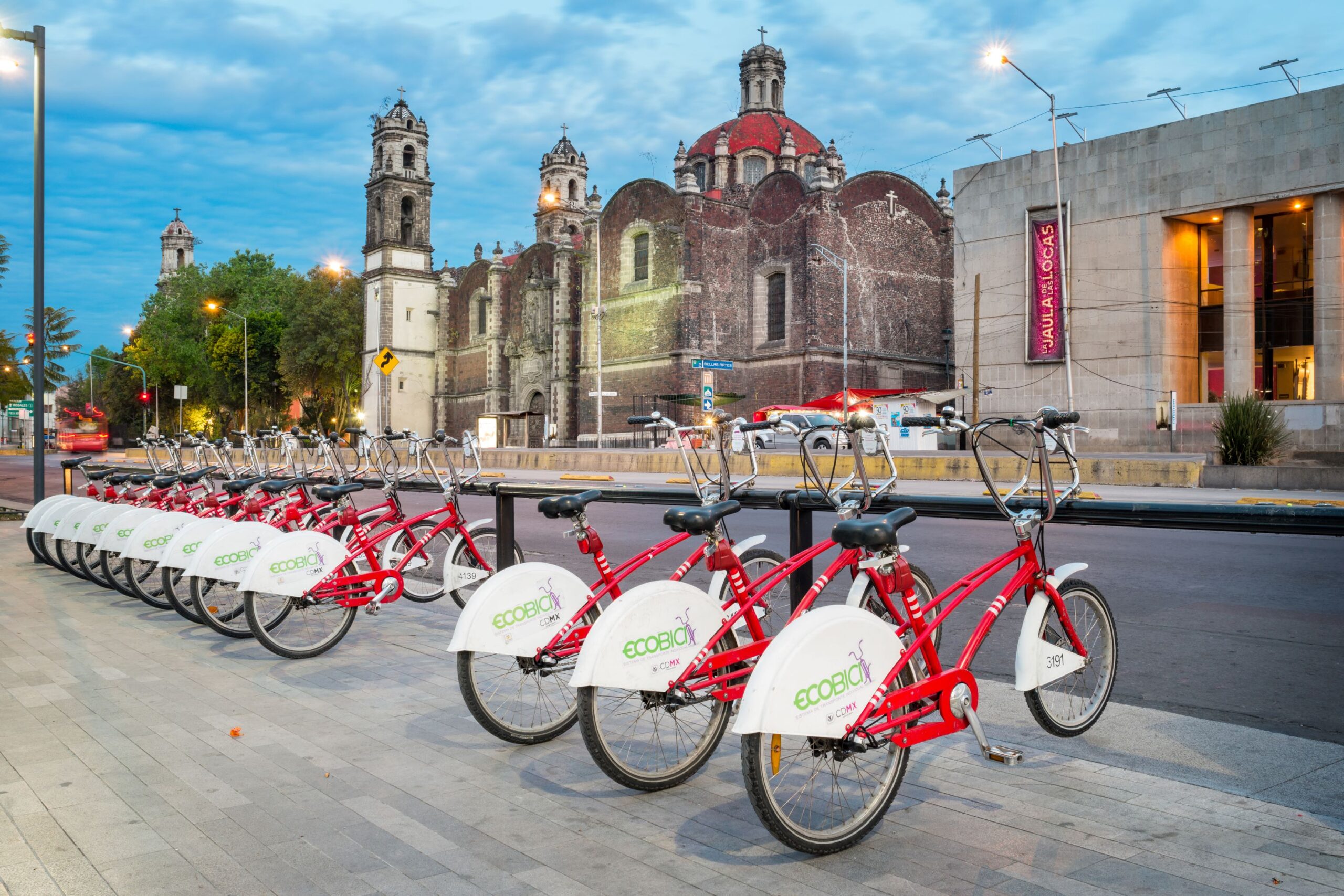
Moving around cities in a variety of ways is getting easier and more convenient: whether it’s improved public transportation systems, wider sidewalks or more dedicated bike lanes. With the rise of smartphone technology and GPS, shared mobility services — like ride-hail and bike-share programs — are growing rapidly and playing an increasingly important role in the transport landscape.
These services aren’t just helping people reach their destinations but can also be leveraged to help people shift to sustainable and safe transportation choices. Emissions from transportation, especially in cities, account for 22% of global fossil-fuel emissions, with private passenger vehicles making up nearly half of these emissions.
However, a more significant shift in urban mobility will be needed to combat the worsening impacts of climate change. To meet critical global climate targets, changes beyond electrification are needed. Cities in low- and middle-income countries need to abate further growth in private vehicle ownership, while cities in high-income countries must focus on reducing existing private vehicle usage. Across all regions, promoting walking, cycling, public transport and the adoption of electric vehicles is essential.
What Are Shared Mobility Services?
Shared mobility solutions like ride-hailing, car-sharing and bike-sharing may play an important role, especially as a last-mile extension or an occasional alternative to mass transit. For example, bike-sharing provides a quick, eco-friendly option for short trips, while car-sharing offers the convenience of a private car without the sunk ownership costs. These flexible alternatives are already transforming urban transport by bringing on a wider variety of transportation options for people to use.
Shared Mobility Services Defined
- Ride-hail: A service where a rider “hails” or hires a personal driver similar to a taxi, to take them exactly where they need to go. The vehicle is not shared with any other party, nor does it make several stops along a route (e.g., Uber, Bolt). Ride-hail improves on taxis by expanding coverage, enhancing systems for personal safety and simplifying payment.
- Ride-share: A service where passengers share a vehicle with others traveling in the same direction, typically coordinated via an app (e.g., BlaBlaCar, Uber pool).
- Bike-share: A service that allows users to rent bicycles from designated stations or zones for short trips, often on a per-minute basis (e.g., CityCycle, Nextbike).
- Car-share: A service where users rent vehicles for short-term use, typically by the hour, from a private owner or a fleet of shared cars (e.g., Zipcar, Turo).
To understand the current landscape of shared services and find ways to increase their usage in cities around the world, WRI conducted research in three cities in Latin America, which have become global leaders in innovative transportation strategies. By gathering insights from Bogotá, Colombia; Mexico City and Curitiba, Brazil, we discovered challenges and opportunities to build inclusive urban mobility systems.
Latin American Cities Leading the Way in Sustainable Transportation
Cities like Curitiba, Bogotá and Mexico City have become pioneers in the sustainable transportation movement, showing that it is possible to create livability without massive budgets. Curitiba introduced the modern bus rapid transit (BRT) system, transforming public transport and urban space. Bogotá advanced the BRT system into a comprehensive network and significantly increased cycling infrastructure, while Mexico City developed an integrated network across several jurisdictions combining metro, BRT, bicycle sharing, and pedestrian-friendly streets. Private cars still only account for less than 25% of trips in each of these cities.
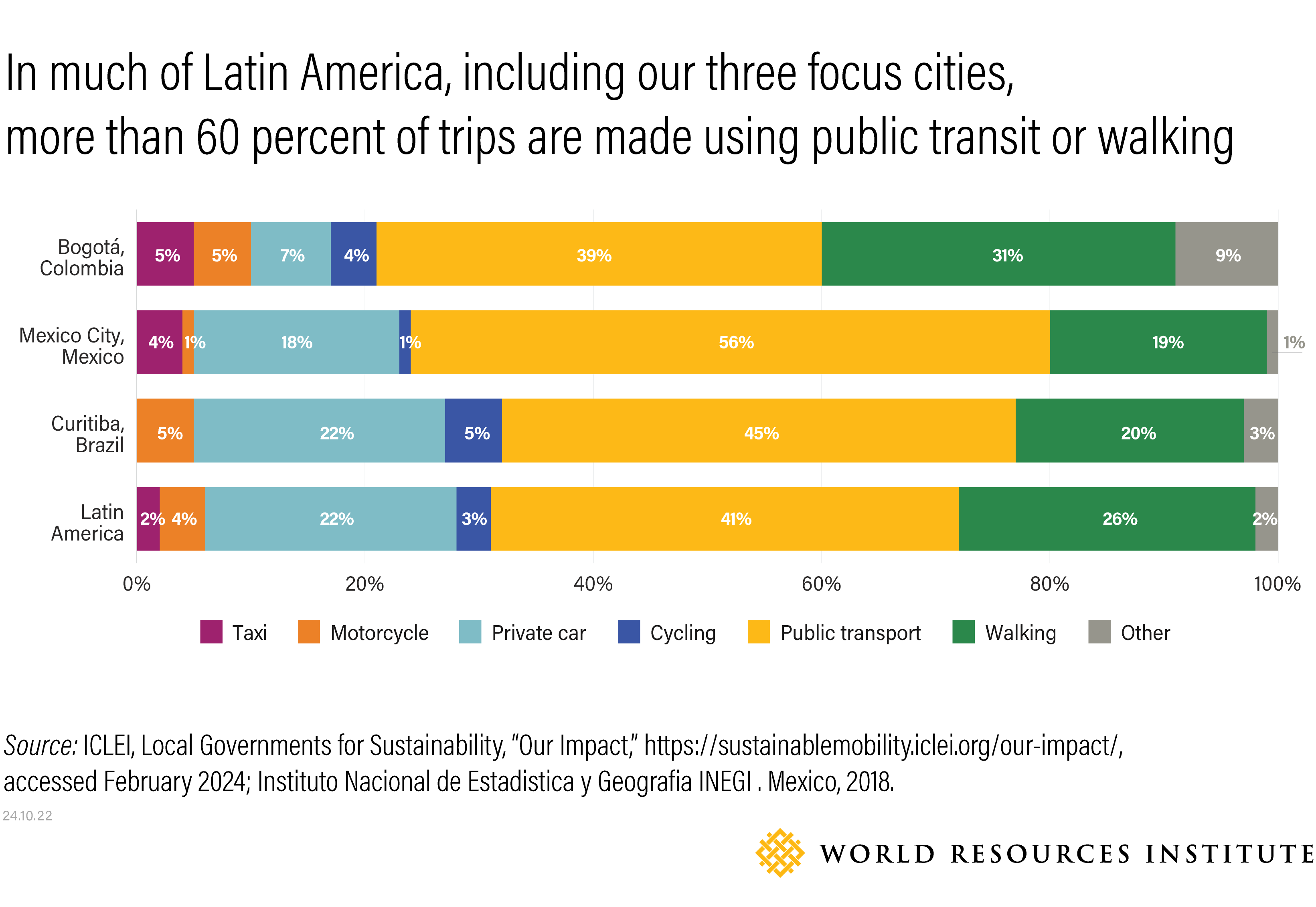
Despite these accolades, ride-hailing apps disrupted existing regulations in Bogotá, Mexico City and Curitiba when they arrived within the past decade, bringing unvetted drivers, tensions with traditional taxis, challenges in insurance and law enforcement, and fluctuating price models that differed from previously regulated fares. While these services grew in popularity, each city responded differently. Brazil legalized ride-hailing in 2018, allowing for Curitiba to enforce local regulations on driver and vehicle licensing requirements, and to make progress on Mobility-as-a-Service pilots. Bogotá still lacks clear regulations for ride-hailing leading to a lack of full formalization. Mexico City faces challenges due to its size and jurisdictional issues but has recently imposed an annual permit fee and mandatory contributions of 1.5% of each ride to fund transportation infrastructure.
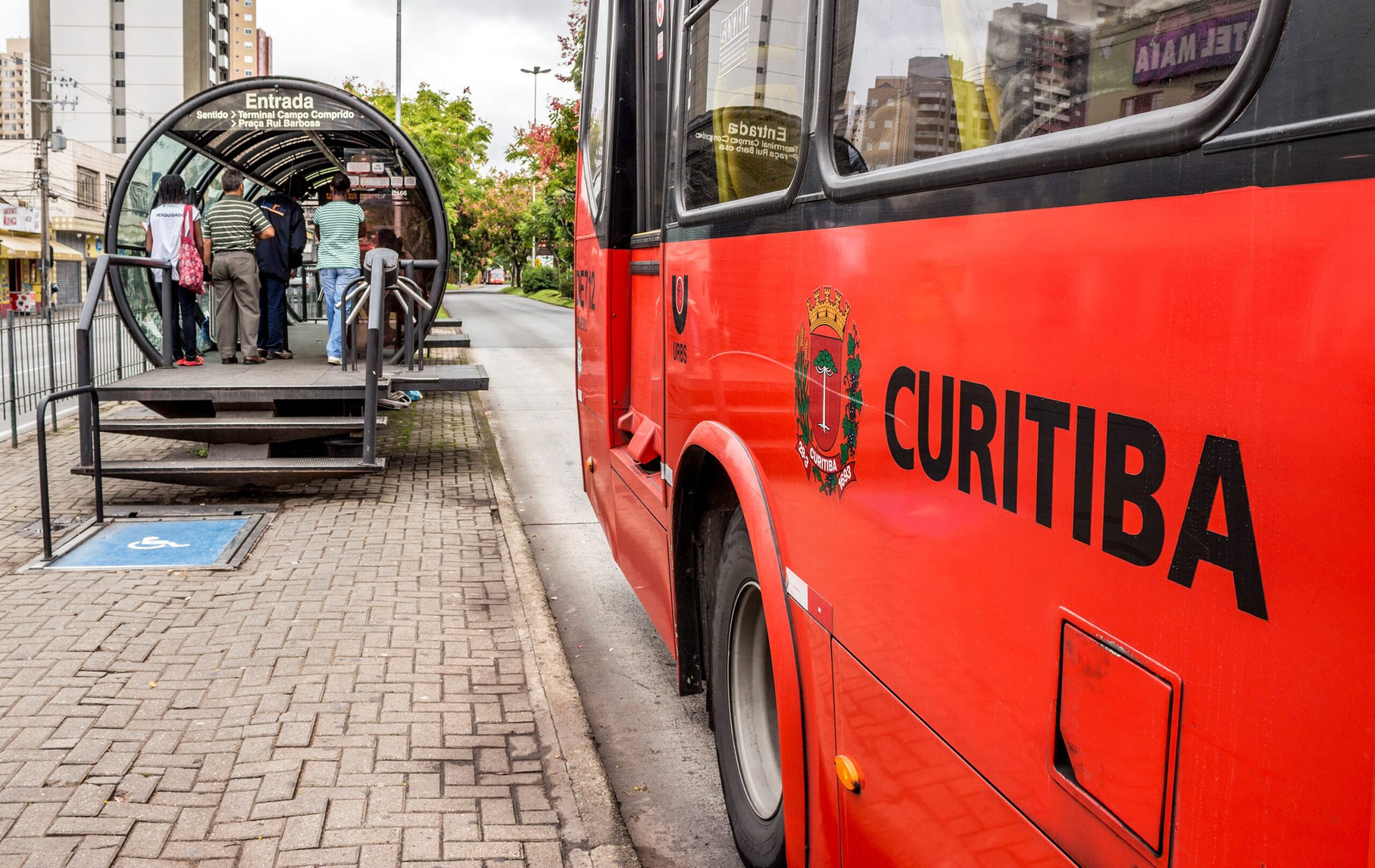
The Goals of Shared Mobility
Shared mobility solutions can be leveraged to significantly enhance existing public transit networks by adding more ways for people to reach their destinations and not become dependent on any single mode. These services can bridge critical gaps by serving areas without subway or bus stops. They are also becoming particularly impactful for first- and last-mile connectivity, for people with disabilities or those carrying large equipment or packages. The services also offer a safer option for those who don’t want to walk home late at night. By reducing dependency on personal cars to accomplish those tasks, shared mobility services can allow households to put off acquiring a first or second car, which translates to greater use of other public transportation options for regular trips.
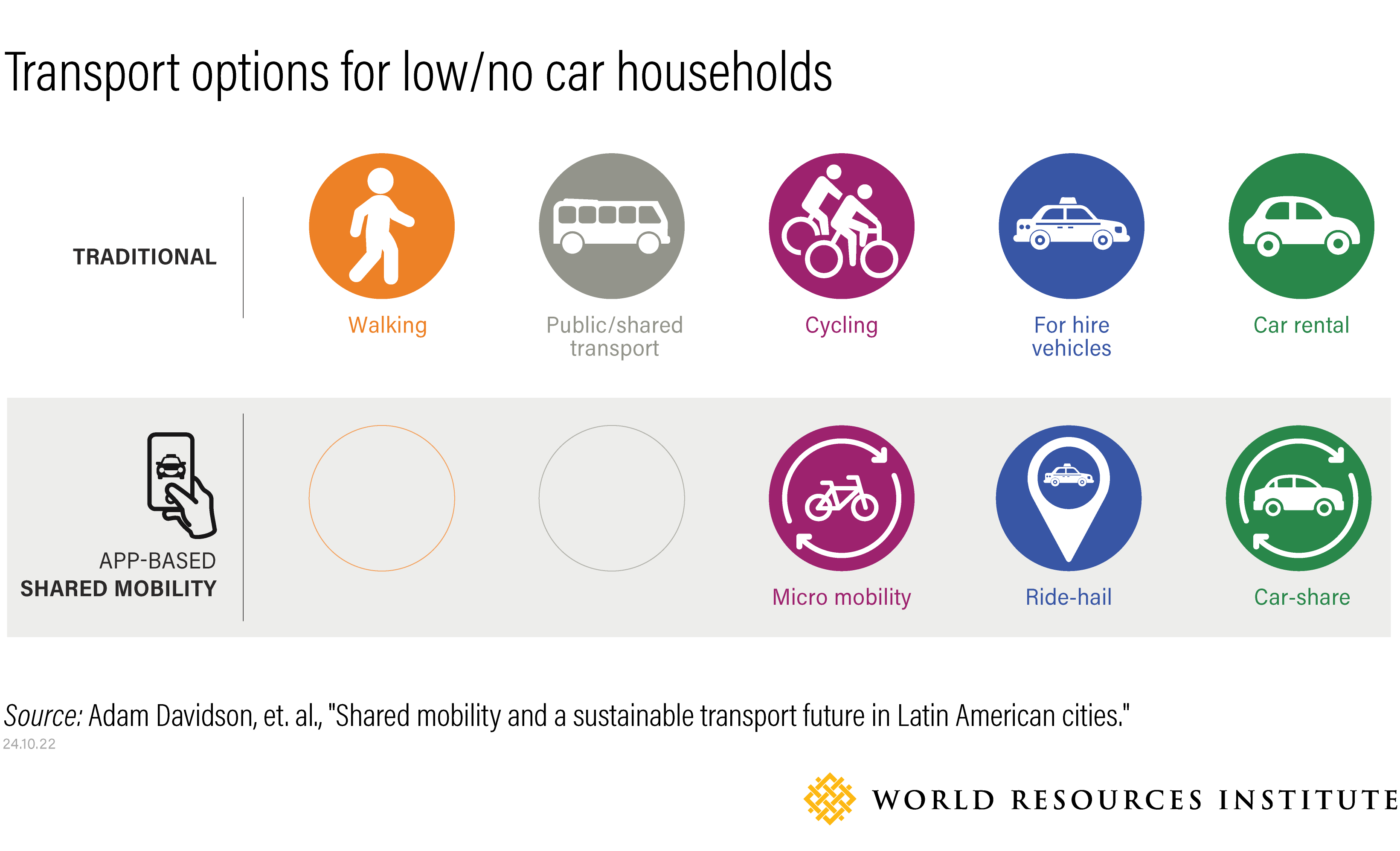
Yet there are challenges to the sustainable use of shared mobility services. On a trip-for-trip basis, shared modes typically produce more carbon emissions than their personal vehicle counterparts. For example, time spent driving in between passengers adds passenger-less carbon emissions and congestion caused by ride-hail services. Similarly, bike-share services produce more carbon emissions than personal bikes as they rely on cargo vans and trucks to help daily with redistribution. However, people who live in areas where bike share is available are more likely to cycle, compared to people who have privately owned bicycles but have no access to bike-share programs. When people have the choice to leverage these shared services, it adds more reliability and accessibility to the transport ecosystem in ways that make it easier to choose lower-carbon options more often leading to a lower emissions profile overall.
Challenges and Opportunities for Shared Mobility in Latin America
While Curitiba, Bogotá and Mexico City have a reputation of taking innovative initiatives to improve their livability, approaches to shared mobility services are mixed. Bogotá has a successful bike-sharing system of over 3,300 bikes, a popular Ciclovía program (80 miles of streets closed to cars every Sunday for the past 50 years) and initiatives to promote electric bikes.
However, the integration of ride-hailing services has been hindered by regulatory challenges, resulting in a legal gray area where these services operate without formalization. Curitiba has been supported by national legislation that has helped stabilize ride-hail services and has recently launched a docked bike-sharing system (“Bicicleta Paraná”) with 500 bikes, half of which are electric. Mexico City has the largest bike-sharing program in Latin America (“Ecobici”) with over 6,000 bikes and a competitive ride-hailing market with an estimated 200,000-plus drivers. However, challenges persist in each place with overcrowded transit and privately-operated minibuses (colectivos).
WRI spoke with experts from government, transportation agencies, ride-hailing companies, researchers and NGOs in a series of workshops to better understand how shared mobility can contribute to more sustainable, low-carbon, equitable and healthy urban transport systems. While our discussions focused locally on Bogotá, Mexico City and Curitiba, what we discovered can be relevant to other large cities in Latin America and elsewhere.
Bogotá, Mexico City and Curitiba share common challenges like improving connectivity and modernizing both formal and informal transit systems. While shared mobility is an accepted tool that has the potential to address many challenges, its success depends on a supportive policy environment, effective governance and active collaboration among transit agencies, private service providers, research organizations, financial institutions and commuters. Additionally, the socioeconomic context of Latin American cities, where income inequality is often high and access to technology can be uneven, presents unique challenges that must be addressed to ensure that shared mobility benefits all segments of the population.
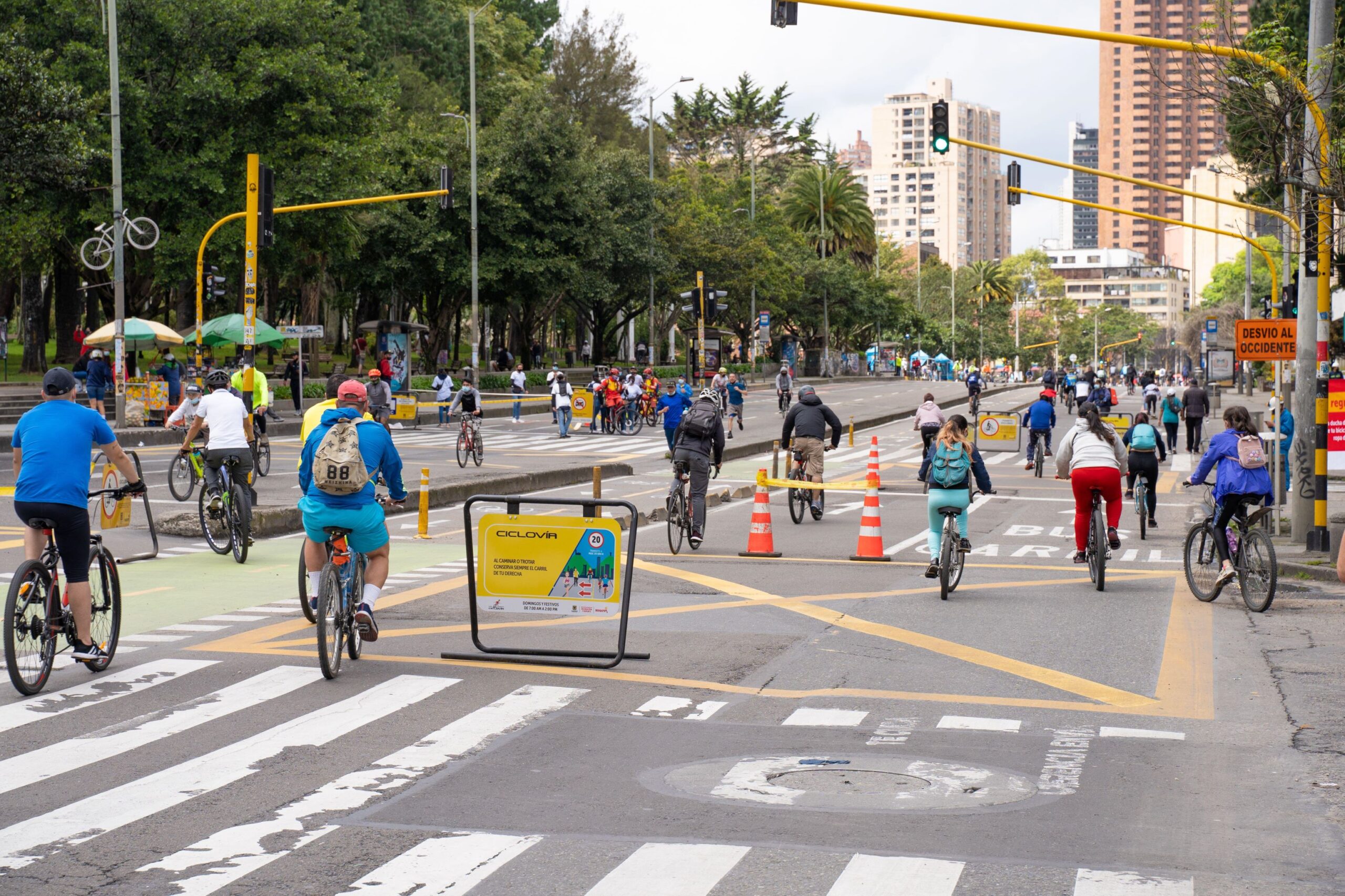
Here are four key takeaways that can help cities in Latin America — and in other cities facing similar challenges — leverage shared mobility to make their transport systems more sustainable.
1) Establish Ongoing Cross-Sector Collaboration
Integrating shared mobility into the urban transportation ecosystem requires continuous dialogue and partnership among government agencies, civil society organizations, nongovernment organizations, shared mobility companies, academic experts and more. In Mexico City, for instance, there’s a need for more flexible pricing, payment and operational models to improve transport coverage in underserved areas.
Collaborative efforts can provide first- and last-mile links and help commuters reach jobs and opportunities, especially in regions outside of city centers. Moreover, leveraging technology and data to integrate various transport modes, such as public transit, walking, cycling and shared mobility, is essential for creating a seamless system.
Curitiba for instance is in the process of integrating diverse mobility options into a single platform, offering integrated payments and incentives for sustainable user behavior.
2) Develop and Implement an Electric Mobility Strategy
Electric vehicles present a significant opportunity for reducing emissions in Latin American cities. However, current adoption rates of light-duty electric vehicles are low. Developing strategies to electrify ride-hailing and for-hire fleets will be important to accelerate their adoption.
Cities like Mexico City and Curitiba are already taking steps to electrify their taxi fleets, but there is also potential in electrifying two- and three-wheelers, such as motorcycle taxis, which are common in many Latin American cities.
Such initiatives can be more affordable and accessible while contributing significantly to decarbonization. To support these efforts, cities need to collaborate with the private sector and other stakeholders to establish phase-out targets for traditional gas and diesel vehicles, provide incentives and develop the necessary charging infrastructure. Effective policies, such as “right to charge” regulations, can ensure that everyone has access to charging facilities within a reasonable distance of their residence.
3) Leverage Data for Sustainable Mobility Solutions
Data is a crucial component for enhancing the effectiveness of shared mobility services and achieving sustainable transportation goals. Our discussions revealed the need for cities and shared mobility providers to engage in data-driven policymaking. By collaborating on the collection and use of data, cities can better understand mobility patterns, identify gaps in service and optimize the efficiency of transportation networks.
For instance, data on emissions, multimodal connectivity and congestion can inform decisions on infrastructure investment and service improvements. Projects like Curitiba’s Hipervisor Urbano, which aims to provide an integrated view of urban planning data, demonstrate the potential of data-driven approaches to urban mobility planning. By establishing clear objectives for data usage, anonymizing information and ensuring data protection, cities can harness the power of data to create more efficient, sustainable and inclusive transport systems.
4) Formalize Ride-Hail Services Through Regulation
Creating a clear and supportive regulatory framework is essential for the successful integration of ride-hail services into the broader urban mobility system. There’s a need for regulations that recognize and formalize the role of ride-hail services within the transportation ecosystem, ensuring that they contribute to sustainability and safety goals.
In Bogotá, where the regulatory environment for ride-hailing remains uncertain, clearer guidelines that promote innovation while safeguarding public interests are needed. A well-defined regulatory framework can help mitigate risks, such as uncapped liabilities, and promote transparency and accountability among service providers. By incorporating ride-hail services into urban and mobility planning, cities can create an integrated network of services that offer reliable, safe and sustainable transport options.
Turning the Corner Toward Shared Mobility
Cities stand at a crucial juncture in their transportation evolution. The workshops in Latin America showed that leveraging shared mobility services like ride-hail, ride-share and bike-share as part of a sustainable urban mobility strategy offers a new tool toward a promising path forward. By fostering collaboration, promoting electric mobility, leveraging data and establishing clear regulations within the shared mobility ecosystem, cities may be able to offer more kinds of transportation while slowing the growth of private car ownership, cutting emissions and improving accessibility for all residents. The discussions from Bogotá, Mexico City and Curitiba demonstrate that there is a need for thoughtful integration, where shared mobility is a vital component of sustainable, inclusive urban transport systems.
As these cities continue to develop and refine their mobility strategies, the key will be to maintain a focus on sustainability, equity and resilience. By prioritizing shared mobility solutions that are flexible, inclusive, and environmentally friendly, Latin American cities can pave the way for a future where urban transportation is not only efficient and convenient but also aligned with global climate and sustainability goals.
This article originally appeared on WRI’s Insights.
Meghna Ray was Policy and Communications Intern for the Urban Mobility program at WRI Ross Center for Sustainable Cities.
Adam Davidson is Senior Urban Mobility Associate at WRI Ross Center for Sustainable Cities.
Anna Kustar is Research Analyst for the Urban Mobility program at WRI Ross Center for Sustainable Cities.





